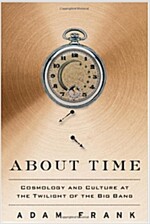
The introduction of mechanical clocks shifted the organization of the European day and eventually provided a new metaphor for the heavens—precise, cosmic clockwork set in motion by God’s hand. Centuries later, the introduction of steam power set the industrial revolution’s new machine age in motion and drove the rhythms of its workers’ punch-clock lives. The science of thermodynamics, emerging from those steam-powered machines, advanced a new understanding of time and transformation in terms of energy, entropy and evolution. Thermodynamics yielded its own metaphors and conceptual tools that reshaped cosmological thinking. Then, just before the dawn of the twentieth century, trains and telegraph wires created new experiences of simultaneity across vast distances. Einstein’s theory of relativity used its own new vision of simultaneity as a pivot point for merging space and time into space-time. Once a fully relativistic account of space-time and its flexible geometry was available, cosmology was given its first complete language. Always and again, transformation in cosmic and human time surged back and forth, each one supporting the other in metaphorical and material realms.
By the last decades of the twentieth century, silicon technology dominated our material engagement with the world. Machines make possible by silicon microcircuits—computers, personal digital assistants, cell phones and GPS devices—were accelerating the immediate and very personal movement through daily life. These silicon “machines” moved at speeds so fast their cadence was far more native to atoms than to humans. By building culture timed to their clock cycles, our own time and experience were compressed in ways both thrilling and exhausting. In both our working and personal lives we were expected to do more because these machines would make it possible...
At the same time, the scientific capacities unleashed in the computer age pushed our cosmic narrative of the Big Bang to its limits. Computer simulations, massive data-gathering projects and space-based telescope platforms revealed new challenges to any cosmology that would begin with a beginning. In closing years of the twentieth century, the pace of life, time and cosmic evolution all were set in a permanent state of acceleration. (pp. 211-212)